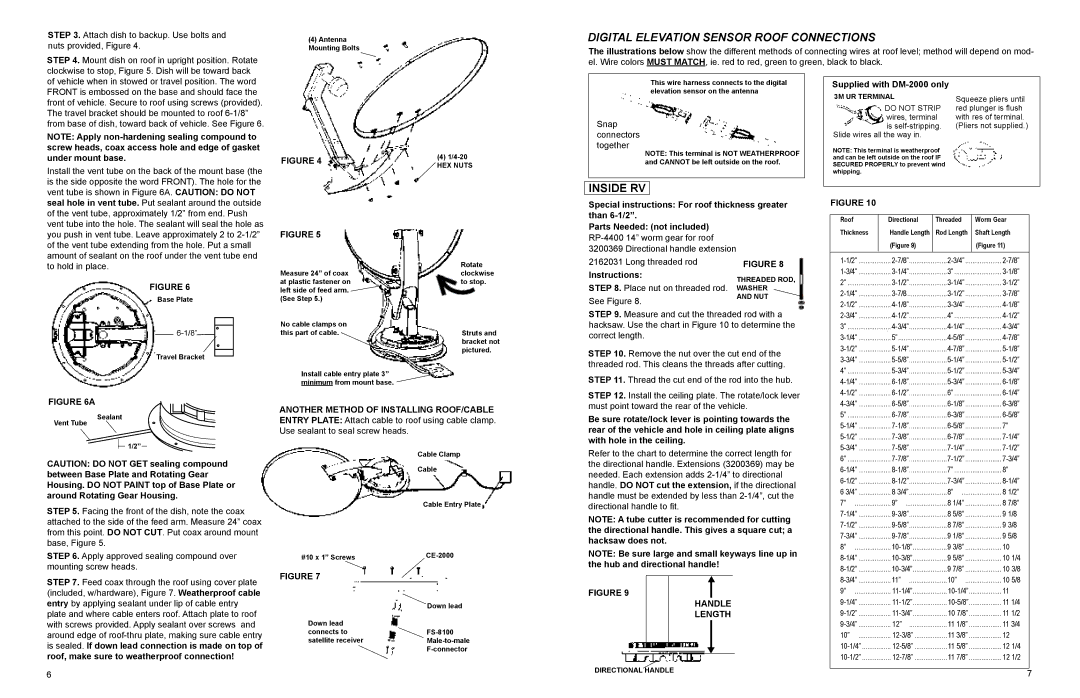
STEP 3. Attach dish to backup. Use bolts and nuts provided, Figure 4.
STEP 4. Mount dish on roof in upright position. Rotate clockwise to stop, Figure 5. Dish will be toward back
(4)Antenna Mounting Bolts
DIGITAL ELEVATION SENSOR ROOF CONNECTIONS
The illustrations below show the different methods of connecting wires at roof level; method will depend on mod- el. Wire colors MUST MATCH, ie. red to red, green to green, black to black.
of vehicle when in stowed or travel position. The word FRONT is embossed on the base and should face the front of vehicle. Secure to roof using screws (provided). The travel bracket should be mounted to roof
NOTE: Apply
Install the vent tube on the back of the mount base (the is the side opposite the word FRONT). The hole for the vent tube is shown in Figure 6A. CAUTION: DO NOT
FIGURE 4
(4)
![]() HEX NUTS
HEX NUTS
This wire harness connects to the digital elevation sensor on the antenna
Snap connectors together
NOTE: This terminal is NOT WEATHERPROOF and CANNOT be left outside on the roof.
INSIDE RV
Supplied with DM-2000 only
3M UR TERMINAL
DO NOT STRIP wires, terminal is
Slide wires all the way in.
NOTE: This terminal is weatherproof and can be left outside on the roof IF SECURED PROPERLY to prevent wind whipping.
Squeeze pliers until red plunger is flush with res of terminal. (Pliers not supplied.)
seal hole in vent tube. Put sealant around the outside of the vent tube, approximately 1/2” from end. Push vent tube into the hole. The sealant will seal the hole as you push in vent tube. Leave approximately 2 to
FIGURE 6
Base Plate
![]()
![]()
Travel Bracket
FIGURE 5
Measure 24” of coax at plastic fastener on left side of feed arm. ![]() (See Step 5.)
(See Step 5.)
No cable clamps on this part of cable.
Install cable entry plate 3” minimum from mount base.
Rotate clockwise to stop.
Struts and bracket not pictured.
Special instructions: For roof thickness greater than
Parts Needed: (not included)
3200369 Directional handle extension
2162031 Long threaded rod FIGURE 8
Instructions: | THREADED ROD, |
| |
STEP 8. Place nut on threaded rod. WASHER | |
See Figure 8. | AND NUT |
| |
STEP 9. Measure and cut the threaded rod with a hacksaw. Use the chart in Figure 10 to determine the correct length.
STEP 10. Remove the nut over the cut end of the threaded rod. This cleans the threads after cutting.
STEP 11. Thread the cut end of the rod into the hub.
FIGURE 10
Roof | Directional | Threaded | Worm Gear |
Thickness | Handle Length | Rod Length | Shaft Length |
| (Figure 9) |
| (Figure 11) |
|
|
|
|
3” | |||
2” | |||
4” | |||
3” | |||
5” | |||
4” | |||
FIGURE 6A
ANOTHER METHOD OF INSTALLING ROOF/CABLE
STEP 12. Install the ceiling plate. The rotate/lock lever must point toward the rear of the vehicle.
6” | |||
Vent Tube
Sealant
![]() 1/2”
1/2”
ENTRY PLATE: Attach cable to roof using cable clamp. Use sealant to seal screw heads.
Cable Clamp
Be sure rotate/lock lever is pointing towards the rear of the vehicle and hole in ceiling plate aligns with hole in the ceiling.
Refer to the chart to determine the correct length for
5” | |||
7” | |||
6” |
CAUTION: DO NOT GET sealing compound between Base Plate and Rotating Gear Housing. DO NOT PAINT top of Base Plate or around Rotating Gear Housing.
STEP 5. Facing the front of the dish, note the coax attached to the side of the feed arm. Measure 24” coax from this point. DO NOT CUT. Put coax around mount base, Figure 5.
STEP 6. Apply approved sealing compound over mounting screw heads.
STEP 7. Feed coax through the roof using cover plate (included, w/hardware), Figure 7. Weatherproof cable entry by applying sealant under lip of cable entry plate and where cable enters roof. Attach plate to roof with screws provided. Apply sealant over screws and around edge of
6
#10 x 1” Screws
FIGURE 7
Down lead connects to satellite receiver
Cable
Cable Entry Plate
Down lead
the directional handle. Extensions (3200369) may be needed. Each extension adds
NOTE: A tube cutter is recommended for cutting the directional handle. This gives a square cut; a hacksaw does not.
NOTE: Be sure large and small keyways line up in the hub and directional handle!
FIGURE 9
HANDLE
LENGTH
DIRECTIONAL HANDLE
7” | 8” | |||
6 3/4” | 8 3/4” | 8” | 8 | 1/2” |
7” | 9” | 8 1/4” | 8 | 7/8” |
8 5/8” | 9 | 1/8 | ||
8 7/8” | 9 | 3/8 | ||
9 1/8” | 9 | 5/8 | ||
8” | 9 3/8” | 10 | ||
9 5/8” | 10 1/4 | |||
9 7/8” | 10 3/8 | |||
11” | 10” | 10 5/8 | ||
9” | 11 | |||
11 1/4 | ||||
10 7/8” | 11 1/2 | |||
12” | 11 1/8” | 11 3/4 | ||
10” | 11 3/8” | 12 | ||
11 5/8” | 12 1/4 | |||
11 7/8” | 12 1/2 | |||
7
